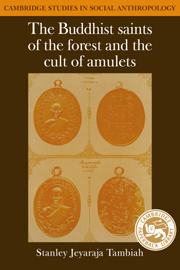Book contents
- Frontmatter
- Contents
- Acknowledgments
- Note on transcription
- 1 Introduction and manifesto
- Part I The arahant and the Path of Meditation
- Part II The hagiography of a Buddhist saint: text and context; the politics of sectarianism
- Part III The cult of amulets: the objectification and transmission of charisma
- 14 The cult of images and amulets
- 15 An enumeration of historic and popular amulets
- 16 The “likeness” of the image to the original Buddha: the case of the Siṅhala Buddha
- 17 The process of sacralizing images and amulets: the transfer of power by monks
- 18 Amulets blessed by contemporary forest saints
- 19 Saints on cosmic mountains
- Part IV Conceptual and theoretical clarifications
- Notes
- Index
- CAMBRIDGE STUDIES IN SOCIAL ANTHROPOLOGY
18 - Amulets blessed by contemporary forest saints
Published online by Cambridge University Press: 10 December 2009
- Frontmatter
- Contents
- Acknowledgments
- Note on transcription
- 1 Introduction and manifesto
- Part I The arahant and the Path of Meditation
- Part II The hagiography of a Buddhist saint: text and context; the politics of sectarianism
- Part III The cult of amulets: the objectification and transmission of charisma
- 14 The cult of images and amulets
- 15 An enumeration of historic and popular amulets
- 16 The “likeness” of the image to the original Buddha: the case of the Siṅhala Buddha
- 17 The process of sacralizing images and amulets: the transfer of power by monks
- 18 Amulets blessed by contemporary forest saints
- 19 Saints on cosmic mountains
- Part IV Conceptual and theoretical clarifications
- Notes
- Index
- CAMBRIDGE STUDIES IN SOCIAL ANTHROPOLOGY
Summary
The phenomenon of amulets is old in Thailand – perhaps as old as religion itself anywhere and everywhere – yet two things are distinctive about the current situation in Thailand. One is that there is an intensification in the traditional cult of amulets. Evidences of this are that there are many new amulets being produced today; there is an inundation of literature about them and their sacralizers; and the bazaar trade as well as the rituals of sacralization of amulets have multiplied. The second feature is that the most famous sacralizers of amulets are some of the forest monks, the meditation masters and saints (arahants) – who have been the focus of the first part of this book. As charismatic persons, some of them are much in the limelight today, and they virtually enjoy a national reputation.
Let me refer the reader back to Chapter 9, “The disciples of the Master”, where I listed some thirteen meditation teachers and heads of forest hermitages, who all claimed to be the disciples, or at least associates, of the famous Meditation Master Mun. These derive to some extent their accreditation through their links to the Master. Compared with him, these disciples showed two shifts. One was that whereas the Master remained peripatetic throughout his life, the disciples have tended to found and/or reside in a single hermitage, though at the same time have themselves established branch hermitages or encouraged pupils to do so. But this is not a major deviation from the Master, for he too, we noticed, established a network of cells of disciples, especially in those monasteries he chose for temporary residence during the rains retreat.
- Type
- Chapter
- Information
- The Buddhist Saints of the Forest and the Cult of Amulets , pp. 258 - 273Publisher: Cambridge University PressPrint publication year: 1984



